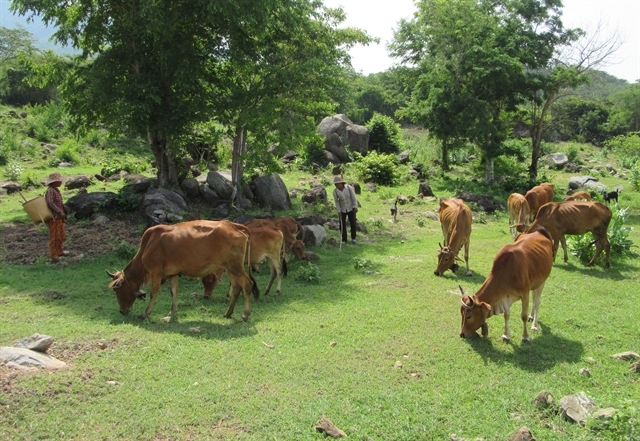 Society
Society

Poverty-reduction models in Ninh Thuận Province’s Bác Ái District have resulted in sustainable poverty reduction, according to the district’s People’s Committee.

|
| Cow breeding has helped many poor households in Ninh Thuận Province’s Bác Ái District escape poverty. — VNA/VNS Photo Nguyễn Thành |
NINH THUẬN — Poverty-reduction models in Ninh Thuận Province’s Bác Ái District have resulted in sustainable poverty reduction, according to the district’s People’s Committee.
The mountainous district is listed as one of the country’s 62 poorest districts under Government Resolution 30a, which addresses sustainable poverty reduction, issued in 2008.
The district has 10 ethnic minorities, with ethnic Raglai accounting for more than 87 per cent of its population.
Farmer Ca Dá Thị Yến, of the district’s Phước Chính Commune, has benefited from the district’s poverty reduction models and escaped poverty. Since 2017, she has received two soft loans worth a total of VNĐ90 million (US$3,900) from the Việt Nam Bank for Social Policy to grow crops and buy cows for breeding.
Commune agricultural officials provided her with instruction on breeding cows, making cowsheds, and growing grasses to feed cows. She now has 12 cows, and has escaped poverty.
Yến is one of many poor people in the district who have benefited from the poverty reduction models.
The district since 2015 has implemented 62 poverty reduction models for plant cultivation and animal husbandry, and has built a new-style rural area. During the period, as many as 28 agriculture extension models helped localities produce high-value products and adapt to climate change.
The farming models include cultivation of grapefruit, durian, honeydew melon, dragon fruit, banana, medicinal plants, hybrid corn, and high-yield cassava, and the raising of cows, goats, sheep and pigs.
The district has also allocated forest areas to local households so that they can both protect and exploit forest resources, and earn an income.
Many co-operatives and co-operative groups in the district have provided vocational skill training to rural labourers. The Phước Thắng General Services Co-operative in Phước Thắng Commune, for example, provides mat weaving training to local Raglai women, which helps them earn additional income in their free time.
In 2015-19, the district mobilised more than VNĐ1.1 trillion ($47.3 million) from central and local budgets and other sources for rural transport, irrigation, power and social welfare projects, and provided vocational skills, jobs and soft loans for local households.
The investment for infrastructure and other projects has helped boost the district’s economic growth by 15 per cent each year during the period.
Last year, the average income per capita in the district increased to VNĐ17.2 million ($740), up 72 per cent against 2015.
As many as 371 poor households last year in the district escaped poverty, reducing the poverty rate to 34.2 per cent. The district has 2,601 poor households and 832 near-poor households.
Despite the achievements, the district faces obstacles in poverty reduction since its economy depends on farming, which is affected by drought and other factors.
The south-central province has the least rainfall in the country, so localities normally face drought in the dry season.
Hồ Xuân Ninh, chairman of the district’s People’s Committee, said the district would seek more investment sources to build new-style rural areas and implement poverty reduction programmes under multidimensional poverty standards this year.
The district will also restructure agricultural production by adapting to climate change, and will transfer the application of advanced techniques to farmers. The district aims to provide more jobs and improve the lives of locals, he said. — VNS